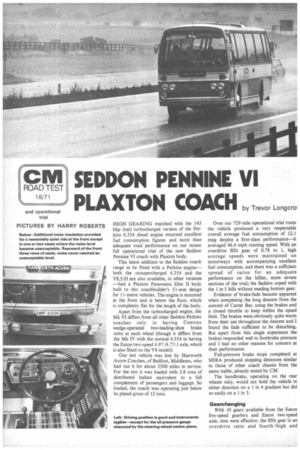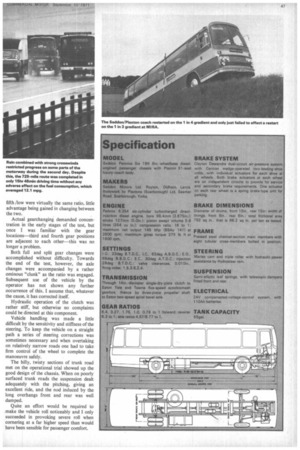CM ROAD TEST SEDDON PENNINE VI 1 PLAXTON COACH by Trevor Longcro .
Page 48

Page 49

If you've noticed an error in this article please click here to report it so we can fix it.
HIGH GEARING matched with the 145 bhp (net) turbocharged version of the Perkins 6.354 diesel engine returned excellent fuel consumption figures and more than adequate road performance on our recent full operational trial of the new Seddon Pennine VI coach with Plaxton body.
This latest addition to the Seddon coach range to be fitted with a Perkins engine— both the unsupercharged 6.354 and the V8.510 are also available, in other versions —had a Plaxton Panorama Elite II body built to this coachbuilder's 51-seat design for 11-metre vehicles. The engine is mounted at the front and is below the floor, which is completely flat for the length of the body.
Apart from the turbocharged engine. the Mk VI differs from all other Seddon-Perkins coaches only in having Centrax wedge-operated two-leading-shoe brake units at each wheel (though it differs from the Mk IV with the normal 6.354 in having the Eaton two-speed 4.97/6.77:1 axle, which is also fitted on the V8 model).
Our test vehicle was lent by Hanworth Acorn Coaches, of Bedfont, Middlesex, who had run it for about 3500 miles in service. For the test it was loaded with 3.8 tons of distributed ballast equivalent to a full complement of passengers and luggage. So loaded, the coach was operating just below its plated gross of 12 tons. Over our 729-mile operational trial route the vehicle produced a very respectable overall average fuel consumption of 12.1 mpg despite a first-class performance—it averaged 46.4 mph running speed. With an overdrive fifth gear of 0.78 to 1, high average speeds were maintained on motorways with accompanying excellent fuel consumption, and there was a sufficient spread of ratios for an adequate performance on the hillier, more severe sections of the trial; the Seddon coped with the 1 in 5 hills without needing bottom gear.
Evidence of brake-fade became apparent when completing the long descent from the summit of Carter Bar, using the brakes and a closed throttle to keep within the speed limit. The brakes were obviously quite warm from their use throughout the descent and I found the fade sufficient to be disturbing. But apart from this single experience the brakes responded well to footbrake pressure and I had no other reasons for concern at their performance.
Full-pressure brake stops completed at MIRA produced stopping distances similar to those of other coach chassis from the same stable, already tested by CM.
The handbrake, operating on the rear wheels only, would not hold the vehicle in either direction on a 1 in 4 gradient but did so easily on a 1 in 5.
Gearchanging
With 10 gears available from the Eaton five-speed gearbox and Eaton two-speed axle, nine were effective: the fifth gear is an overdrive ratio and fourth /high and fifth /low were virtually the same ratio, little advantage being gained in changing between the two.
Actual gearchanging demanded concentration in the early stages of the test, but once I was familiar with the gear locations—third and fourth gear positions are adjacent to each other—this was no longer a problem.
Both full and split gear changes were accomplished without difficulty. Towards the end of the test, however, the axle changes were accompanied by a rather ominous "clunk" as the ratio was engaged. Subsequent use of the vehicle by the operator has not shown any further occurrence of this. I assume that, whatever the cause, it has corrected itself.
Hydraulic operation of the clutch was rather stiff, but otherwise no complaints could be directed at this component.
Vehicle handling was made a little difficult by the sensitivity and stiffness of the steering. To keep the vehicle on a straight path a series of steering corrections was sometimes necessary and when overtaking on relatively narrow roads one had to take firm control of the wheel to complete the manoeuvre safely.
The hilly, twisty sections of trunk road met on the operational trial showed up the good design of the chassis. When on poorly surfaced trunk roads the suspension dealt adequately with the pitching, giving an excellent ride, and the nod induced by the long overhangs front and rear was well damped.
Quite an effort would be required to make the vehicle roll noticeably and I only succeeded in provoking severe roll when cornering at a far higher speed than would have been sensible for passenger comfort.




























































































